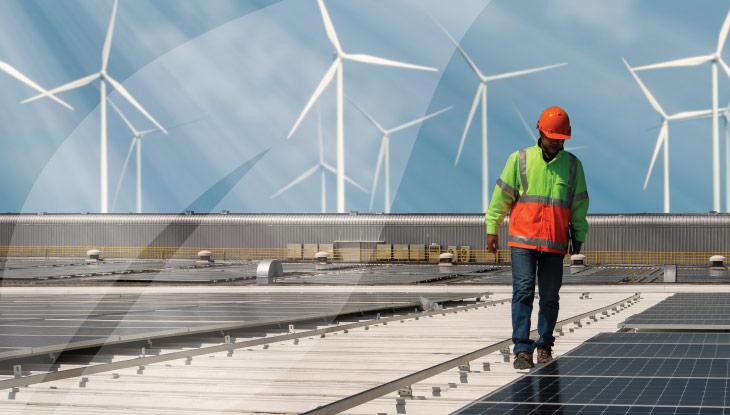Why Are Energy Prices Going Up?
Regardless of the sector you work in, you’ll have undoubtedly noticed the rise in energy prices. That could be with your business gas and electricity bills, with the cost of heating your home, or as the dominant story over the news.
But this rise in price isn’t as simple as it first may seem, with a huge amount of factors contributing towards the higher cost of electricity and gas.
We’ll look at what you need to know about the rising prices of business utilities, and how you can put steps into place to futureproof your energy needs, as well as what the next few months and years could hold for businesses and their energy usage.
What Are Energy Prices Now?

It’s difficult to give a full overview of the current prices of business electricity and gas, especially as different suppliers price their services differently, based on their own profits and overheads.
The ideal way to discover the best possible price is through a business energy price comparison service, which are dedicated to discovering the best possible price for the size of your business, and the sector you operate in.
In the interests of giving a comprehensive overview, we’ll use Ofgem’s statistics. These show an astronomical rise since March of 2021, with a steady decline over the last few months, largely down to government schemes.
However, electricity prices are currently hovering at more than double their price from 2020, and the same is true of gas prices.
We’ll touch on the reasons for that substantial increase in our next section, but the data only gives one side of the story. Conservative estimates using Ofgem’s information, alongside data from Statista, mean that:
- A very small (“micro”) business (less than 10 people) uses around 12,500 kWh across both gas and electric. This equates to around £793 per year for gas, and £2,911 for gas, and £2,911 for electricity.
- Small businesses (less than 50 employees) are estimated to use around 35,000 kWh, meaning an average yearly gas bill of £2,015, and around £7,400 on electricity.
- Mid-sized businesses (below 250 employees) have an estimated annual usage 70,000 kWh, which means an annual gas bill of £4,218, and an electricity bill of around £12,829.
- Larger businesses (over 250 employees) will naturally use much more energy. They’re estimated to use around 165,000 kWh, means a yearly gas bill of £8,735, and annual electricity charges of a whopping £30,156.
Of course, these are all estimates, and individual energy suppliers may charge more or less. The energy market is saturated with suppliers, all of whom are looking to attract businesses with fluctuating demands through cheaper prices, lower standing charges, and better service.
However, what this data serves to highlight is the need for effective services in place that allow you to switch your business gas and electricity.
Why Are Energy Prices So High?

This is a complex question. While the recent global energy crisis seems to largely be behind us, the aftermath is only just beginning, and business gas and electricity prices are still much higher than they were pre-pandemic.
There are numerous political and socio-economic factors that influence the overall price point you’ll pay to power your business. Let’s explore a few of those key reasons behind our current higher prices.
- The Conflict In Ukraine – As you’ll undoubtedly have seen over the last year, the Ukraine war has had far-reaching, devastating impacts. In a show of solidarity with Ukraine and the Ukrainian people, energy firms have moved away from Russian industry, which offered large quantities of gas power at a much cheaper rate than other sources. This has meant a higher initial cost of acquiring the gas, which means higher prices for business gas.
- Supply Shortages – An unusually cold winter between 2020 and 2021 meant that businesses required more energy over that period, leading to lower supply reserves than usual. Not only that, but with the rise in more people working from home, and businesses.
- The Global Pandemic – As the world recovers from the COVID-19 pandemic, business energy prices are finding stability in what is still an unstable market. With all lockdown restrictions now lifted, businesses are seeing an influx of customers and clients, which means greater electricity, gas and water demands.
- Low Gas Reserves – The UK’s infrastructure means we don’t stockpile nearly as much gas as other European countries, with The Telegraph estimating that the UK stores just enough to cover 4 – 5 winter days. This means that many companies need to pay costly import charges to bring power to businesses and consumers.
- Instability In The UK Energy Market – With a difficult pandemic now behind us, the fallout has hit energy firms hard. Over 20 energy firms have gone under or closed completely since the start of 2021, which has meant uncertain times for providers and consumers alike.
- Nord Stream 1 Closure & Nord Stream 2 Delays – Closed in 2017, the Nord Stream 1 was one of the largest gas pipelines across all of Europe, stretching from Russia to Germany. Without this pipeline, supplies were substantially reduced, and its closure meant that there needed to be a solution in place. This was set to be the revamped Nord Stream 2, but conflict in Ukraine, and Russia’s position as a volatile global power, meant that Germany put consigned the project to an indefinite hiatus.
- Dwindling Government Support – Recently, the government’s energy guarantee scheme has ensured that households and businesses alike had support over the autumn and winter months. This has now dried up substantially, and the future of government funding is now uncertain. We’ll look at this in more detail in our next section.
These aren’t the only factors to have contributed towards this overall upward trend in gas and electricity prices, but they are large reasons behind the energy market crisis.
It’s also important to consider how demand has risen to meet the shifting global climate, with business energy needs increasing as temperatures fluctuate.
The changing landscape of the world does mean uncertainty in the future, but as clean energy sources become more mainstream, and different suppliers opt for new and innovative strategies, understanding the energy market is crucial.
What Support Is Currently Available For Businesses?
In recent months, the UK Government has run a scheme that offer businesses and consumers money off their energy bills. This was the Energy Price Guarantee, which meant that bills stayed consistent, and that businesses wouldn’t face insurmountable energy bills.
For consumers, this was in the form of money off their monthly bills, but for business energy needs, this worked slightly differently.
According to the BBC, businesses were offered a discount based on a price that was subsidised by the Government, ensuring that prices rose at a rate that was both affordable and forecastable for companies of all sizes. This ran from November 2022 (backdated to October 2022), with the last payment set to land in March 2023.
From April of 2023, that support is due to stop, with a new scheme to be put into place for business electricity and gas.
The new scheme, aimed at providing support that kicks in when business energy prices are at their highest rather than the previous model that offered a flat discount, is set to be in place until March 2024.
Does This Mean That Energy Prices Are On The Rise?

This is yet to be confirmed, but early signs point towards a slight rise before they to decline to the levels seen before the global energy crisis that started in 2021. This is still more than twice as high as energy prices have been in recent memory, but it could represent a return to normality after the business gas and electricity crisis.
The scaled-back support that starts from April of this year means that businesses could see a substantial increase in the next 12 months, with March being the last month of the government cap on business gas and electricity prices.
One of the key takeaways from recent Government reports is that support would need to be scaled back from the £18.4 billion we’d seen over recent months, to a more manageable £5.5 billion.
While concrete figures have yet to be seen, the response to the Chancellor’s latest plans for business energy solutions have been mixed.
The report detailed how the amount of support a business will receive for their energy needs is proportional to both the size of their business, and the sector they operate in.
Smaller businesses will receive much less government-supported relief than larger ones for their business electricity and gas, which could impact already struggling firms, particularly those on variable tariffs.
The general advice for smaller or “micro” businesses is to look at services that allow you to switch your business gas and electricity provider, and secure a more consistent price as energy rates start to fluctuate again.
On the other hand, larger companies, and those operating on an industrial scale (like steel or textiles), are set to receive much more support than smaller companies. It’s all part of an effort to inject life into those industries and reinvigorate local economies through better job opportunities and greater investment.
Is It Cheaper To Opt For Renewable Energy?

Firstly, renewable energy is always the best way forward. It’s much better for the environment, offers ways to promote sustainable and long-lasting initiatives, and essentially helps your business look to the future in a positive way.
It’s also the direction that many providers of business electricity and gas are taking, which means that it’s soon to become the norm for modern utilities.
However, because of the complex way that UK energy suppliers distribute electricity (through a model called “marginal cost pricing”), the price of renewable energy isn’t set by the cost of a wind turbine or hydroelectric dam – it’s set by the most expensive source the supplier used.
This means that, despite moving away from fossil fuels, renewable energy costs are usually decided by natural gas.
A study from the UCL found that, over the last few years, the cost of natural gas determined the cost of electricity (from both renewable and non-renewable sources) more than 80% of the time, meaning that renewable energy bills closely mirrored those from non-renewable sources.
While this is under review from the government, it’s unfortunately meant that renewable energy in recent time hasn’t been the cheaper alternative for business gas and electricity that many were hoping it would be.
However, changes in government policy could mean that renewable clean energy soon shifts to a more cost-efficient model. “Contracts For Difference” is a government scheme that aims to ensure that energy from renewable sources is substantially cheaper than those from fossil fuels.
The hope is that this will not only ensure cheaper rates of electricity and gas for businesses and consumers, but that it’ll also help avert any future energy crisis or shortages.
As more and more energy providers get on board with this, and we start to look to the future of energy and a world without fossil fuels, it’s abundantly clear that taking advantage of a service to switch your business energy is the way forward.
What Is The Future Of Business Energy Prices?
As we start to leave times of uncertainty, and recover from the electricity and gas crisis of the last few months, it’s natural to look to the future, and plan for your business’ gas and electricity needs.
While there’s no way to know exactly how much businesses can expect to pay for their utilities over the next year, we can look at a few key events and changes that will change the landscape of energy costs.
The government’s plan to adjust the amount of help that businesses receive for their energy bills is set to take effect from April 2023, and could mean that you’ll be paying more for your business electricity and gas.
At its core, this new deal provides less support to smaller businesses, but ultimately more investment and support for larger or industrial-scale businesses. We’re yet to see the full effects of this new scheme, but we’ll likely learn more over the coming months.
What does remain certain, though, is that the ideal way to combat any future price rises or changes to the landscape of how companies receive their utilities is through an effective service that allows you to switch your business energy provider.
Plus, by opting to switch your business electricity and gas company now, you’re effectively planning for the future.
The UK’s commitment to going net zero by as soon as 2050, and a promise of a huge £90 billion investment in 2035 to support environmental initiatives and green industry, are huge landmarks on the horizon, and represent a big focal point for businesses and their energy needs.
Fossil fuel supplies are dwindling, and there’s undoubtedly been a global shift towards energy sources that are renewable or “cleaner”, like wind, solar, or hydropower. The landscape of energy is changing, and it’s vital for you and your business to be aware of that.
How Can I Switch My Business Energy Provider?
Changing business energy providers can be a challenging and time-consuming process, especially if you’re unsure of what your business needs.
That’s where Tariff comes in. As one of the UK’s leading energy switching services, our specially trained professionals will cover every aspect of the journey, from learning about you and your business, to onboarding your business with your new supplier.
We’re here at every step of the way, offering tailored advice and guidance to ensure you get not only the best deal on your business energy needs, but a supplier that has the future in mind with what they do.
Get started by contacting us here, or give one of our knowledgeable, friendly operatives a call on the free phone number at the top of the website.




